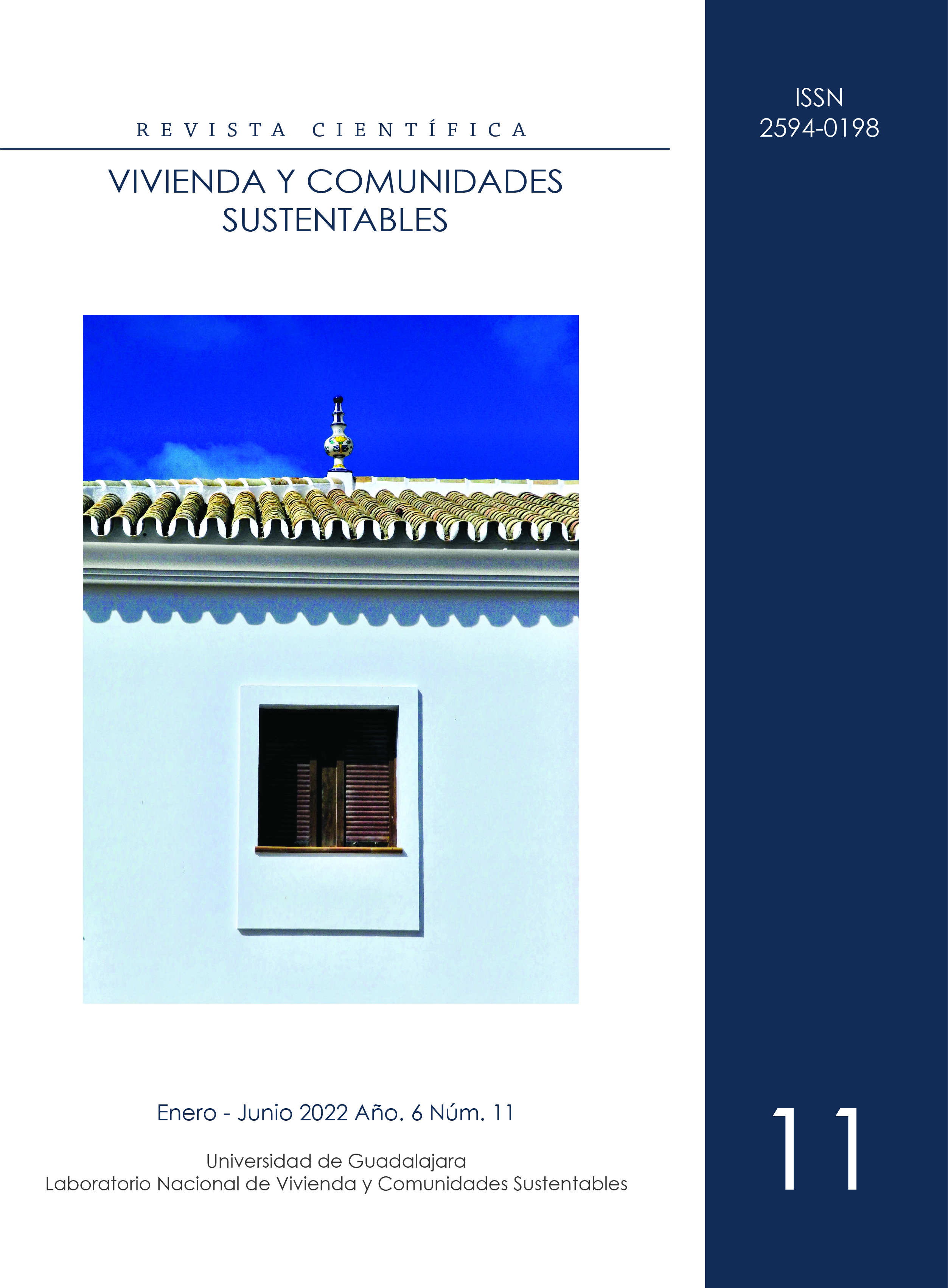Modular bajareque for semiarid regions
Alternative building system for rural dwelling in Torreon, Mexico
DOI:
https://doi.org/10.32870/rvcs.v0i11.177Keywords:
embodied energy, air pollution, climate change, sustainable construction, rural housingAbstract
The construction of bajareque structures has proven to be highly sustainable from an ecological, economic and sociocultural point of view, which is why it served as a reference for the realization of a technified prototype at the Autonomous University of Coahuila in Torreón. From the quantification of materials, the volumetric weight, the incorporated energy and the CO2 emissions have been comparatively analyzed in relation to a model made with conventional construction systems, quantitatively demonstrating remarkable ecological qualities of an alternative system built with technified bajareque.Metrics
References
Acosta, D. (2009). Arquitectura y construcción sostenibles: Conceptos, problemas y estrategias. Dearq, s/v, (4), 14-23.
https://doi.org/10.18389/dearq4.2009.02
Alcorn, A. (2003). Embodied energy and CO2 coefficients for NZ building materials. Wellington, New Zealand: Victoria University.
Alcorn, A. (2010). Global sustainability and the New Zealand house (doctoral thesis). Victoria University, Wellington, New Zealand.
Arguello, T. y Cuchí, A. (2008). Análisis del impacto ambiental asociado a los materiales de construcción empleados en las viviendas de bajo coste del programa 10x10 con Techo-Chiapas del CYTED. Informes de la construcción, 60 (509), 25-34. https://doi.org/10.3989/ic.2008.v60.i509.588
https://doi.org/10.3989/ic.2008.v60.i509.588
Banco Mundial (2019). Porcentaje de población urbana mundial. Disponible en: https://datos.bancomundial.org/indicador/SP.URB.TOTL.IN.ZS
Banco Mundial (2020). Emisiones mundiales de CO2. Disponible en: https://datos.bancomundial.org/indicador/EN.ATM.CO2E.KT?end=2016&name_desc=false&start=1970
Berge, B. (2009). The ecology of building materials. Oxford, United Kingdom: Elsevier.
https://doi.org/10.4324/9780080949741
CEMEX (2005). Manual del constructor. Ciudad de México, México: Talleres de proceso gráfico.
Ching, F. y Shapiro, I. (2014). Arquitectura ecológica: Un manual ilustrado. Barcelona, España: Gustavo Gili.
CIB (2002). Agenda 21 for sustainable construction in developing countries. Disponible en: https://www.irbnet.de/daten/iconda/CIB3150.pdf
Guerrero, L. (2017). Pasado y porvenir de la construcción con bajareque. Revista Gremium, 4 (8), 69-80. Disponible en: file:///C:/Users/A/AppData/Local/Temp/DialnetPasadoYPorvenirDeLaConstruccionConBajareque-6067557.pdf. https://doi.org/10.56039/rgn08a07
Guerrero, L. y Soria, F.J. (2018) Traditional architecture and sustainable conservation. Journal of Cultural Heritage Management and Sustainable Development, 8 (2), 194-206. https://doi.org/10.1108/JCHMSD-06-2017-0036
GIZ (2016). El libro de la vulnerabilidad. Conceptos y lineamientos para la evaluación estandarizada de la vulnerabilidad. Disponible en: https://www.adaptationcommunity.net/download/va/vulnerability-guides-manuals-reports/giz_sbv_ES_SOURCEBOOK_screen_v171019.pdf
IPCC (2014). Cambio climático 2014 Informe de síntesis: Resumen para responsables de políticas. Disponible en: https://www.ipcc.ch/site/assets/uploads/2018/02/AR5_SYR_FINAL_SPM_es.pdf
IPCC (2015). Cambio climático 2014, Mitigación del Cambio Climático: Resumen para responsables de políticas y resumen técnico. Disponible en: https://archive.ipcc.ch/pdf/assessment-report/ar5/wg3/WGIIIAR5_SPM_TS_Volume_es.pdf
Kibert, C. J. (2013). Sustainable construction: Green building design and delivery. New Jersey, USA: Wiley
Kim, J. & Rigdon, B. (1998). Qualities, use and examples of sustainable building materials. Disponible en: http://www.umich.edu/~nppcpub/resources/compendia/ARCHpdfs/ARCHsbmIntro.pdf
Meadows, D., Meadows, D. L., Randers, J. & Behrens, W. (1972). The limits to growth: A report for the of Rome's project on the predicament of makind. New York, USA: Universe Books.
https://doi.org/10.1349/ddlp.1
Minke, G. (2005) Manual de construcción en tierra. Montevideo, Uruguay: Fin de siglo.
Rocha, E. (2011). Construcciones sostenibles: materiales, certificaciones y LCA. Revista Nodo, 6 (11), 99-Recuperado de: http://revistas.uan.edu.co/index.php/nodo/article/view/64
UNEP (2013). Sustainable solutions for social housing: guidelines for project developers. Disponible en: https://www.unep.org/search/node?keys=social+housing&category=All&type=All&topic=All®ion=All
UN-Habitat (2012). Going green: A handbook of sustainable housing practices in developing countries. Disponible en: https://unhabitat.org/sites/default/files/download-manager-files/Going%20Green.pdf
World Meteorological Organization (2018). Understanding the IPCC Special Report on 1.5°C. Disponible en: https://public.wmo.int/en/resources/library/understanding-ipcc-special-report-15%C2%B0c
World Meteorological Organization (2019). WMO Greenhouse Gas Bulletin. The State of Greenhouse Gases in the Atmosphere Based on Global Observations through 2019. Disponible en: https://library.wmo.int/doc_num.php?explnum_id=10437
Published
How to Cite
Issue
Section
License
Copyright (c) 2022 Vivienda y Comunidades Sustentables

This work is licensed under a Creative Commons Attribution-NonCommercial-NoDerivatives 4.0 International License.
The authors who publish in this journal accept the following conditions:
In accordance with the copyright legislation, Sustainable Housing and Communities recognizes and respects the moral right of the authors, as well as the ownership of the patrimonial right, which will be transferred to the University of Guadalajara for its dissemination in open access. Sustainable Housing and Communities does not charge authors for submitting and processing articles for publication. Authors may make other independent and additional contractual agreements for the non-exclusive distribution of the version of the article published in Sustainable Housing and Communities (for example, include it in an institutional repository or publish it in a book) as long as they clearly indicate that the work is published for the first time in Sustainable Housing and Communities.






